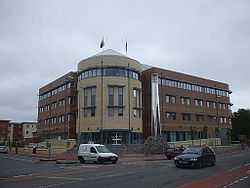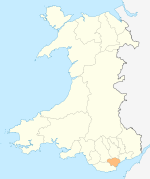Butetown
Coordinates: 51°28′01″N 3°09′58″W / 51.467°N 3.166°W

Butetown (or The Docks, Welsh: Tre-biwt) is a community in the south of the city of Cardiff, the capital of Wales. It was originally a model housing estate built in the early nineteenth century by John Crichton-Stuart, 2nd Marquess of Bute, for whose title the area was named. Commonly known as "Tiger Bay", this area became one of the UK's first multicultural communities with people from over 50 countries settled here by the outbreak of World War I, working in the docks and allied industries. Some of the largest communities included the Somalis, Yemenis and Greeks, whose influence still lives on today. A Greek Orthodox church still stands at the top of Bute Street. It is known as one of the "five towns of Cardiff", the others being Crockhertown, Grangetown, Newtown and Temperance Town. The population of the ward taken at the 2011 census was 10,125.[1]
Development

In the 1960s, most of the original housing was demolished including the historic Loudoun Square, the original heart of Butetown. In its place was a typical 1960s housing estate of low-rise courts and alleys, and two high rise apartment blocks.
In the 1980s, the new Atlantic Wharf development was built on the reclaimed West Bute Dock, and has involved the construction of some 1300 new houses. Together with the developments in the Inner Habour and Roath Basin, it was hoped this would spur redevelopment and employment in Butetown, but it seems not to have. The divide between the wealthy Cardiff Bay, and the poor Tiger Bay seems as wide as ever, although some of the surviving areas of historic Butetown are becoming prime office and retail locations. With the new Century Wharf development to the west on the banks of the Taff, the housing estate is becoming a little 'boxed in', increasing feelings of exclusion. Over the next few decades, the 1960s housing will require renewal and it is hoped that new development will be more suitable of the urban context of the area and will provide a better mix of private and public housing to help fully integrate the community with the rest of the city.
A three-year £13m project to redevelop a shopping parade, community hub, health centre and homes in Butetown began in 2010. The Loudoun Square development will include environmental aspects such as harvesting rain water. The project is a collaboration between Cardiff Community Housing Association (CCHA), Cardiff Council and Cardiff and Vale University Health Board. The facilities and 62 new homes will follow four years of consultation with local residents.[2]
Demographics
The 2011 census included the following demographic information:[3]
- Overall Population: 10,125
- White: 65.7%
- Black: 11.3%
- Asian: 9.7%%
- Mixed Ethnicity: 5.7%
- Other Ethnic Groups: 7.7%
People identifying themselves as Welsh: 42.8%
The Welsh Language
The growth of the docks in the mid nineteenth century attracted a significant Welsh-speaking community to the area.[4] To serve this community three Welsh-language chapels were opened: Bethania, Loudon Square (Calvinistic Methodist; opened 1853, closed 1937); Mount Stuart (Congregationalist; opened 1858, relocated to Pomeroy Street in 1912); and Siloam, Mount Stuart Square (Baptist; opened 1860, relocated to Grangetown in 1902). A Welsh-speaking Anglican church also opened in the area in 1856 (All Saints on Tyndall Street; Welsh-language services moved elsewhere in 1870). One of the members of Butetown’s Welsh-speaking community was Evan Rees (Dyfed), a worker in the Bute Docks in the 1870s and a future Archdruid of Wales.[5]
The 1891 census showed that 15% of Butetown’s population could speak Welsh, significantly higher than the Cardiff average of 10.7%. Some parts had a particularly high percentage, such as the Loudon Square/James Street area (28%). During the twentieth century, however, the percentage declined, although Welsh-speakers remained a recognized part of the local community.[6]
In the 2011 census it was recorded that 928 or 9.6% of Butetown residents (over 3 years old) could speak Welsh. This was a significant increase on the figures for the 2001 census, which were 356 and 8.3%.[7]
Transport

The area is served by Cardiff Bay railway station with shuttle services every 12 minutes to Cardiff Queen Street. Cardiff Bus operates the 11 service to Pengam Green via Central Station, Splott and Tremorfa and the 35 service to Gabalfa via Central Stn and Cathays. It also on the 1/2 Bay Circle route connecting the area with Grangetown, Canton, Fairwater, Llandaff, Gabalfa, Heath, Cathays, Roath, Tremorfa, Splott and the City Centre. Butetown also enjoys the incorporating Cardiff Bay, thus benefiting from its public transport opportunities such as the Baycar bus route.
Bute Street and Lloyd George Avenue, running parallel, link the area to the city centre. Also, the A4232 links it to Culverhouse Cross and the M4 J33 Cardiff West to the west and to Adamsdown in the east.
Government
The electoral ward of Butetown is located in the parliamentary constituency of Cardiff South and Penarth. It is bounded by the wards of Cathays and Adamsdown to the north; Splott to the northeast; Severn estuary to the southeast; and Grangetown to the west.
On Cardiff Council, the Butetown ward is represented by Cllr Ali Ahmed (Labour).[8]
Images of Butetown
-

Nelson House,
Butetown -

Loudoun House,
Butetown -

Queen's Gate Tunnel (Butetown tunnel) -

Taff Viaduct
(Butetown Link Road) -

HSBC Bank, Bute Street -
.jpg)
The former Cory’s Building
See also
Notes
- ↑ "Cardiff ward population 2011.Retrieved 5 April 2015".
- ↑ BBC News | £13m regeneration boost for Cardiff community
- ↑ 2011 Census Key Statistics - Butetown; accessed 2 February 2015.
- ↑ The following two paragraphs are based on Simon Brooks, ‘Tiger Bay a'r diwylliant Cymraeg’, Transactions of the Honourable Society of Cymmrodorion, 2009, pp. 198-216 (available on-line here). Accessed 2 February 2015.
- ↑ Thomas Bowen, Dinas Caerdydd a'i Methodistiaeth Galfinaidd (Caerdydd, 1927), p. 81.
- ↑ Neil M. C. Sinclair, The Tiger Bay Story (Cardiff, 1997), pp. 58 and 129.
- ↑ Welsh Language Commissioner: 2011 Census results by Community; accessed 24 January 2015.
- ↑ Malone, Sam (4 May 2012). "Labour takes Cardiff's Butetown ward from the Lib Dems". WalesOnline. Retrieved 3 July 2012.
| |||||||||||||||||||||
| ||||||||||||||||||||||||||||||||||


